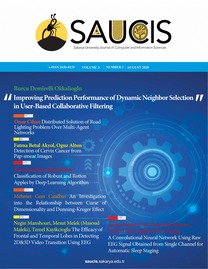Calculation of Driving Parameters for GOA4 Signaling System using Machine Learning Methods
___
[1] Y. Chen and L. R. Rilett, “A train speed measurement and arrival time prediction system for highway-rail grade crossings”, Transportation Research Record Journal of the Transportation Research Board, vol. 2608, no.1., pp. 96-104, 2017.[2] T. Ogawa, S. Manabe, G. Yoshikawa, Y. Imamura, and M. Kageyama, “Method of Calculating Running Resistance by the Use of the Train Data Collection Device”, Quarterly Report of RTRI, no. 58, pp. 21-27, 2017.
[3] K. N. Cosgriff, E. G. Berggren, A. M. Kaynia, N. N. Dam, and N. A. Mortensen, “new method for estimation of critical speed for railway tracks on soft ground”, International Journal of Rail Transportation, vol. 6, no. 4, pp. 203-217, 2018.
[4] S. Hensel, M. Marinov, “Time Signal Based Warping Algorithms for Low Speed Velocity Estimation of Rail Vehicles”, Annual Journal of Electronics, no. 8., pp. 177-180, 2014.
[5] G. Xu, F. Li, J. Long, and D. Han, “Train movement simulation by element increment method”, Journal of advanced transportation, no. 50, pp. 2060–2076, 2017.
[6] Z. Lv, J. Xu, K. Zheng, H. Yin, P. Zhao, and X. Zhou, “LC-RNN: A Deep Learning Model for Traffic Speed Prediction”, in Proceedings of the Twenty-Seventh International Joint Conference on Artificial Intelligence (IJCAI-18), 2018, pp. 3470-3476.
[7] A. Dhamaniya and S. Chandra, “Speed Prediction Models for Urban Arterials under Mixed Traffic Conditions”, Procedia-Social and Behavioral Sciences, no. 104, pp. 342 – 351, 2013.
[8] S. Aradi, T. Becsi, and P. Gaspar, “Estimation of running resistance of electric trains based on on-board telematics system”, International Journal of Heavy Vehicle Systems, no. 22, pp. 277- 291, 2015.
[9] M. Gmira, M. Gendreau, A. Lodi, and J. Potvin, “Travel Speed Prediction Based on Learning Methods For Home Delivery”, Interuniversity Research Center On Business Networks, logistics and transport, pp. 1-34, 2018.
[10] M. Bysveen, Vehicle speed prediction models for consideration of energy demand within road design, Norwegian University of Science and Technology, Civil and Environmental Engineering, Master’s Thesis, 2017.
[11] B. Mirbaha, M. Saffarzadeh, S. A. Beheshty, M. Aniran, M. Yazdani, and B. Shirini, “Predicting Average Vehicle Speed in Two Lane Highways Considering Weather Condition and Traffic Characteristics”, IOP Conference Series: Materials Science and Engineering, pp. 1- 7, 2017.
[12] M. Gmira, M. Gendreau, A. Lodi, and J. Potvin, “Travel speed prediction using machine learning techniques”, ITS World Congress, pp. 1-10, 2017.
[13] E. Naye, Real-time arrival prediction models for light rail train systems, Royal Instistute of Technology, Department of Engineering, Master’s Thesis, 2014.
[14] O. Cats, “Real-Time Predictions for Light Rail Train Systems”, 17th International IEEE Conference on Intelligent Transportation Systems (ITSC), pp. 1-10, 2014.
[15] G. Kouroussis, D. P. Connolly, M. Forde, and O. Verlinden, “Train speed calculation using ground vibrations”, Proceedings of the Institution of Mechanical Engineers, Part F: Journal of Rail and Rapid Transit, vol. 229, no. 5, pp. 466-483, 2015.
[16] D. Freedman, Statistical Models: Theory and Practice, Cambridge: Cambridge University Press, pp.25, 2005.
[17] A. C. Rencher, and W. F. Christensen, “Chapter 10, Multivariate regression – Section 10.1, Introduction”, Methods of Multivariate Analysis, Wiley Series in Probability and Statistics, 709 (3rd ed.), John Wiley & Sons, pp. 19, 2012.
[18] Available: https://www.analyticsvidhya.com/blog/2020/05/decision-tree-vs-random-forestalgorithm/
[19] T. K. Ho, “Random Decision Forest”, Proceedings of the 3rd International Conference on Document Analysis and Recognition, Montreal, 14-16 August, pp. 278-282, 1995.
[20] L. Breiman, “Random Forests”, Machine Learning, vol. 45, no. 1, pp. 5–32, 2001.
[21] J. A. Freeman and D. M. Skapura, “Neural Networks Algorithms”, Applications and Programming Techniques, New York, USA: Addison-Wesley Publishing Company, 1991.
[22] G. J. Garret and C. Wu, “Knowledge‐based modeling of material behavior with neural networks”, Journal of Engineering Mechanics, vol. 117, no.1, pp. 132-153, 1991.
[23] T. M. Cover, and P. E. Hart, “Nearest neighbor pattern classification”, IEEE Transactions on Information Theory, vol. 13, no. 1, pp. 21–27, 1967.
[24] J. Walters-Williams, Y. Li, “Comparative study of distance functions for nearest neighbors”, In Advanced Techniques in Computing Sciences and Software Engineering, Springer, Dordrecht, pp. 79-84, 2010.
[25] M. Akçay, “Estimation of Constant Speed Time for Railway Vehicles by Stochastic Gradient Descent Algorithm”, Sakarya University Journal of Computer and Information Sciences, vol. 3, no. 3, pp. 355-365, 2020.
- ISSN: 2636-8129
- Yayın Aralığı: Yılda 3 Sayı
- Başlangıç: 2018
Calculation of Driving Parameters for GOA4 Signaling System using Machine Learning Methods
Mehmet Taciddin AKÇAY, Abdurrahim AKGUNDOGDU
Classification of Imbalanced Offensive Dataset – Sentence Generation for Minority Class with LSTM
Terrorism in Cyberspace : A Critical Review of Dark Web Studies under the Terrorism Landscape
Eda SÖNMEZ, Keziban SEÇKİN CODAL
Performance Analysis of Chaotic Neural Network and Chaotic Cat Map Based Image Encryption
A Novel Hybrid Binary Farmland Fertility Algorithm with Naïve Bayes for Diagnosis of Heart Disease
